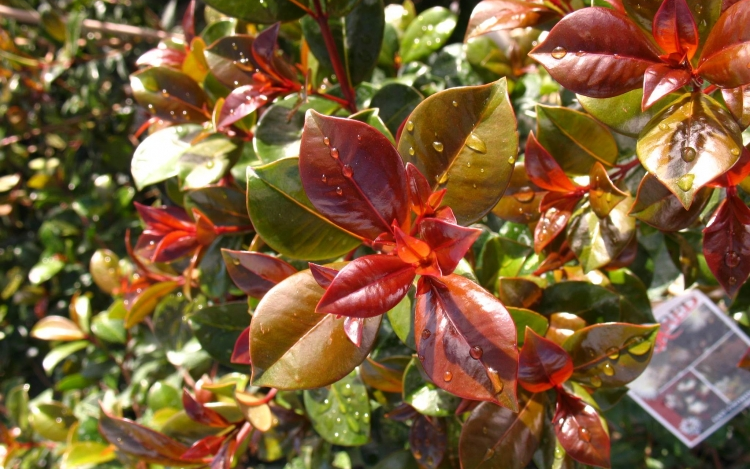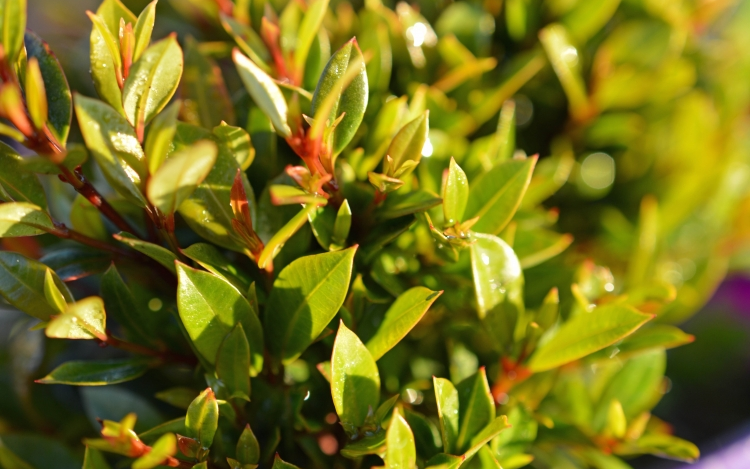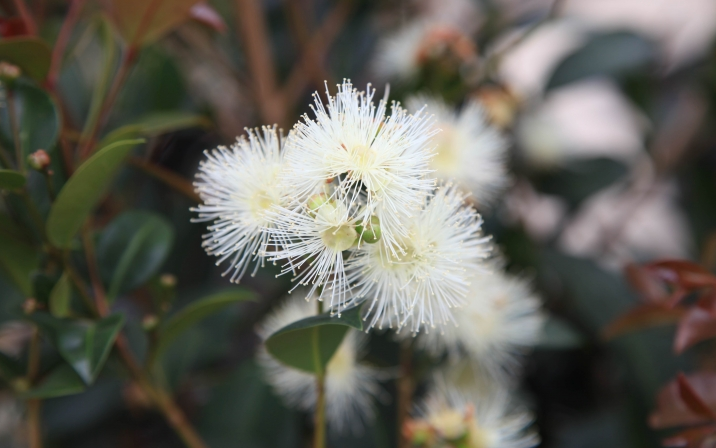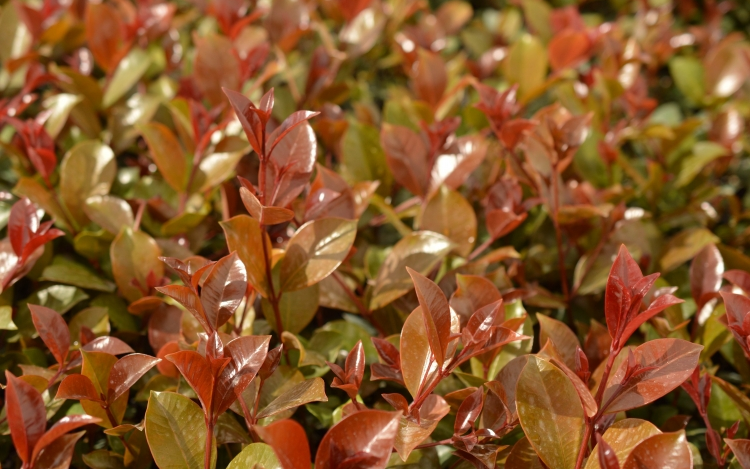
A brief introduction to Lilly Pilly
Lilly Pilly, also known as Syzygium and Acmena, are a group of evergreen shrubs and small trees that are native to Australia and Papua New Guinea. They are popular for their attractive foliage, colourful berries, and versatility in the garden.
There are many different varieties of Lilly Pillys, each with their own unique characteristics. Some popular varieties include Syzygium australe, also known as the Brush Cherry, which has glossy green leaves and red berries, and Acmena smithii, also known as the Lilly Pilly, which has dark green leaves and white flowers.
Lilly Pillys are great for use as hedges and feature plants in a garden. They can be grown as a formal hedge, or left to grow naturally for a more informal look. They are also great for use as a screen or privacy barrier. They are fast-growing and can reach heights of up to 10 meters, making them perfect for large gardens and properties.

This is why Lilly Pillys are so popular
One of the best things about Lilly Pillys is that they are very low maintenance. They are drought-tolerant and can grow in a variety of soils, making them easy to care for. They also don’t require regular pruning to stay healthy, although they can be pruned to shape if you are trying to achieve a formal look.
Another great aspect of Lilly Pillys is that they are very versatile in terms of design. They can be used as a specimen plant in a garden bed, as a border along a driveway, as a hedge or screen, or as a topiary, making them a great addition to any garden.
In the rest of this article, we are going to answer the most common questions people have about Lilly Pillys.
What soil, sun, and weather conditions do Lilly Pillys like?
Lilly Pillys are generally adaptable to a wide range of soil, sun, and weather conditions.
In terms of soil, they prefer well-drained soils, but can also tolerate clay soils and sandy soils. They are also tolerant of alkaline and slightly acidic soils. It is important to ensure that the soil is moist, but not waterlogged.
In terms of sun, Lilly Pillys prefers full sun to partial shade. They can tolerate full shade, but they may not produce as much fruit and may have less vibrant foliage in these conditions.
In terms of weather, Lilly Pillys are hardy and can tolerate temperatures as low as -5°C, but they are not frost-tolerant. (This product is great for helping with frost; best applied before the frost but can also help after or during a cold snap.) They also prefer a humid environment but can tolerate dry conditions once established. They are also tolerant of strong winds, making them a good choice for coastal gardens.
In general, Lilly Pillys are tough plants that can adapt to a wide range of conditions, making them a great choice for many different types of gardens. It’s always a good idea to check the specific variety of Lilly Pilly you have as some specific ones might have a different requirements.
Four popular Lilly Pillys
Syzygium “Tiny Trev”

Syzygium “Tiny Trev” is a cultivar of Syzygium australe. It is a compact, dwarf variety of the species, reaching a maximum height of around 1 meters.
One of the main attractive features of “Tiny Trev” is its small size and compact growth habit, making it perfect for small gardens, courtyards, or even as a potted plant. It has glossy green leaves that are smaller than the species, and during the summer it produces clusters of small, white flowers that are followed by red berries.
“Tiny Trev” is a versatile plant that can be used as a hedge, feature plant, or screen. It can be pruned to shape and can also be used as a topiary. It is fast-growing and tolerates a wide range of soil, sun, and weather conditions, making it easy to care for. You can buy Syzygium “Tiny Trev” here
Syzygium “Orange Twist”

Syzygium “Orange Twist” is a cultivar of the Lilly Pilly, known for its unique and striking foliage. It is an evergreen shrub that can grow up to 3 meters tall, although it can be kept smaller with regular pruning.
One of the most attractive features of Syzygium “Orange Twist” is its twisted and curled new growth, which is a vibrant orange colour. As the leaves mature, they turn to a deep green colour, creating a striking contrast.
It produces small white flowers that bloom in the summer, followed by small red berries that are attractive to birds. The berries are also edible for humans, but they have a sour taste.
Syzygium “Orange Twist” is a versatile plant that can be used as a hedge, feature plant, or screen. It is fast-growing and tolerates a wide range of soil, sun, and weather conditions, making it easy to care for. You can buy Syzygium “Orange Twist” here
Syzygium “Big Red”

Syzygium “Big Red” is a cultivar of the Lilly Pilly, known for its vibrant red new growth and large glossy green leaves. It is an evergreen shrub that can grow up to 5-6 meters tall, although it can be kept smaller with regular pruning.
One of the most attractive features of Syzygium “Big Red” is its vibrant red new growth that contrasts nicely with the large glossy green leaves, it’s a great plant to use as a feature plant or to create a focal point in the garden.
The plant produces small white flowers that bloom in the summer, followed by small red berries that are attractive to birds. The berries are also edible for humans, but they have a sour taste.
Syzygium “Big Red” is a versatile plant that can be used as a hedge, feature plant, or screen. It is fast-growing and tolerates a wide range of soil, sun, and weather conditions, making it easy to care for. You can buy Syzygium “Big Red” Here
Acmena “Cherry Surprise”

Acmena “Cherry Surprise” is a cultivar of Acmena smithii, commonly known as Lilly Pilly. It is a small to medium-sized shrub or small tree that is native to Australia.
The Acmena Cherry Surprise is a compact and hardy plant, it grows to around 3-4 meters tall and 2-3 meters wide. It has a dense, glossy, dark green foliage that turns to a bright red colour when it is new. It produces small, creamy-white flowers that are followed by small, dark red berries.
The Acmena Cherry Surprise is a versatile plant, it can be grown as a hedge, a feature plant, or in a container. It prefers well-drained soils, and can tolerate a range of soil types and conditions. It prefers full sun to partial shade, and is drought-tolerant once established.
It requires minimal maintenance and is relatively low-maintenance, but regular pruning and shaping can help to maintain its compact form. It is also relatively hardy and adaptable to different weather conditions. You can buy Acmena “Cherry Surprise” here.
How much water do Lilly Pillys need?

Lilly Pillys are relatively drought-tolerant plants, once established, they can survive with minimal watering. However, for optimal growth and to ensure the plants are healthy, they do require regular watering.
During the first few months after planting, Lilly Pillys should be watered regularly to ensure that the soil stays moist. After that, the frequency of watering will depend on the weather conditions and the soil type.
During hot and dry weather, Lilly Pillys may need to be watered more frequently, while during cooler and wetter weather, they may need less watering. In general, it is best to water Lilly Pillys deeply and infrequently, rather than watering them shallowly and frequently. This will encourage deep root growth and make the plants more drought-tolerant.
It’s also important to make sure that the soil is well-draining, Lilly Pillys don’t tolerate waterlogged soil. It’s always a good idea to check the soil moisture before watering, if the soil is still moist there is no need to water.
How often should Lilly Pillys be pruned?

The frequency of pruning depends on what your goals are for your garden. Lilly Pillys do not require regular pruning to stay healthy, but regular pruning can shape the plant into a beautiful formal hedge or even a featured topiary.
Formal hedges will need to be pruned every 4-8 weeks depending on weather conditions, time of year and type of Lilly Pilly. Topiary will likely need even more frequent attention. However, if you simply want to keep the plant healthy then remove dead, damaged, or diseased branches when you notice them. No regular hedging is needed.
How to prune Lilly Pilly.
To keep the shape of the plant, you can prune it lightly after it finishes flowering to remove any straggly or crossing branches. If you want to control the size of the plant, you can prune it back more severely in late winter or early spring, before new growth begins.
If you’re looking to encourage bushier growth, you can perform tip pruning, which involves pinching back the tips of the branches regularly throughout the growing season. This will encourage the plant to produce more branches and foliage, creating a denser plant.
To prune a formal hedge use a hedge trimmer to keep your hedge to it’s desired size. More frequent hedging will result in denser, tighter hedges.
It’s important to note that excessive pruning can reduce the number of flowers and fruit produced by the plant, so if flowering is your goal it’s best to prune only as needed. Also, when pruning, be sure to use sharp, clean tools and make clean cuts just above a bud or a node.
In summary, Lilly Pillys do not require regular pruning, but occasional pruning can help maintain shape and size, or encourage bushier growth and regular hedging can help create a beautiful formal hedge.
You can prune lightly after flowering to remove straggly or crossing branches, or prune back severely in late winter or early spring to control size. Regular tip pruning can also encourage bushier growth, but keep in mind that excessive pruning can reduce flowers and fruit production. It’s important to use sharp, clean tools and make clean cuts when pruning.

Are Lilly Pillys good for topiary?
Lilly Pillys can be used for topiary, as they have a dense foliage and a compact growth habit that make them well suited for shaping and training into various forms.
The most common topiary forms for Lilly Pillys are as hedges and formal hedges, as well as standards, balls, and spiral shapes. They can also be trained into shapes such as animals, geometric shapes, and architectural forms.
When using Lilly Pillys for topiary, it’s important to choose a variety that is suitable for the desired form and size. Frequent pruning is also needed to maintain any topiary.
In summary, Lilly Pillys can be used for topiary as they have a dense foliage and a compact growth habit that make them well suited for shaping and training into various forms, such as hedges, standards, balls, and spiral shapes. It’s important to choose a variety that is suitable for the desired form and size, and to prune and shape the plant regularly to maintain the desired form.
What pests are common with Lilly Pillys?

Lilly Pillys can be affected by a variety of pests, some of the common ones include:
- Scale insects: These are small, hard-shelled pests that attach themselves to the stems and leaves of the plant and suck the sap, causing yellowing and wilting of leaves. They can also produce a sticky honeydew which can lead to the growth of sooty mold.
- Mealybugs: These are small, white, cottony insects that suck the sap from the plant. They can cause yellowing and wilting of leaves, and can also produce a sticky honeydew.
- Psyllids: These are small, winged insects that feed on the sap of the plant. They can cause the leaves to curl and distort, and can also produce a sticky honeydew.
- Spider mites: These are tiny, spider-like insects that feed on the sap of the plant. They can cause yellowing and stippling of the leaves, and can also spin fine webs on the plant.
- Caterpillars: Some species of caterpillars can feed on the leaves of Lilly Pillys, causing defoliation.
It’s important to monitor your plants regularly for signs of pests and take action as soon as possible to prevent them from causing serious damage. Chemical pesticides are available for treating these pests, but it’s always best to try to use less toxic and more environmentally friendly methods of pest control, like horticultural oil, neem oil, insecticidal soap, and horticultural dust, or even introducing predators insects to your garden. (Here is where you can find some neem oil)

What diseases are common with Lilly Pillys?
Lilly Pillys can be affected by a variety of diseases, some of the common ones include:
- Phytophthora root rot: This is a fungal disease that attacks the roots of the plant, causing wilting, yellowing, and death of the plant. It is typically caused by waterlogged soil and can be prevented by ensuring good drainage.
- Powdery mildew: This is a fungal disease that causes a white, powdery coating on the leaves and stems of the plant. It is most common in humid conditions and can be controlled by improving air circulation and by avoiding overhead watering. (Here is an organic fungicide that will help with Powdery Mildew and Black Spot.)
- Bacterial blight: This is a bacterial disease that causes water-soaked lesions on the leaves, stems, and fruit of the plant. It is spread by water and can be controlled by maintaining good sanitation and avoiding overhead watering.
It’s important to monitor your plants regularly for signs of disease and to take action as soon as possible to prevent them from causing serious damage. Proper cultural care such as adequate irrigation, fertilization, and pruning, as well as avoiding overcrowding, can help prevent or minimize the impact of diseases. If you suspect a disease it’s best to consult with a professional or your local extension office for a proper diagnosis and treatment options.

How should I fertilise my Lilly Pilly?
Fertilizing your Lilly Pilly can help promote healthy growth and improve the overall appearance of the plant. Here are some tips on how to properly fertilise your Lilly Pilly:
- Timing: The best time to fertilise your Lilly Pilly is in the spring, just before new growth begins. This will ensure that the plant has the necessary nutrients to put on strong, healthy growth.
- Fertiliser type: Lilly Pillys prefer a balanced fertiliser. Look for a fertiliser with an NPK ratio of around 3-1-1 or 4-1-1. You can also use slow-release fertiliser, or organic fertilisers such as well-rotted manure or compost. Baileys 311 is a great product for Lilly Pilly that you can find here.
- Application: Always follow the instructions on the fertiliser package for the recommended application rate. In general, it’s best to apply the fertiliser at the base of the plant, avoiding the foliage. Water the plant well after fertilizing, to help the fertiliser reach the roots.
- Quantity: Lilly Pillys don’t require heavy fertilization, it’s best to start with a small amount of fertiliser and gradually increase as necessary. Over-fertilizing can cause excessive growth, which can make the plant more susceptible to pests and diseases.
- Maintenance: The plant will benefit from regular fertilization, but it’s important to monitor the plant’s growth and adjust the fertilization schedule accordingly. In general, a fertiliser application every 6-8 weeks during the growing season is adequate.
In summary, fertilizing your Lilly Pilly can help promote healthy growth and improve the overall appearance of the plant. The best time to fertilise is in the spring, just before new growth begins, with a balanced fertiliser with equal amounts of nitrogen, phosphorus, and potassium. Avoid over-fertilizing, always follow the instructions on the fertiliser package, and monitor the plant’s growth to adjust the fertilization schedule accordingly.

How fast does a Lilly Pilly grow?
0.5 – 2 meters per year. The growth rate of a Lilly Pilly can vary depending on the variety and the growing conditions. The smaller varieties will likely grow slower and likewise the larger varieties will grow faster.
Lilly Pillys are considered fast-growing, under ideal conditions shrubs or small trees can grow up to 1 meter per year. They can be pruned to control size, and can be used as hedges, screens, or feature plants in gardens. Large Lilly Pilly trees can grow up to 2 meters per year.
It’s important to note that the growth rate of Lilly Pillys can be affected by factors such as soil type, water, sunlight, and temperature. Lilly Pillys prefer well-drained soils, and they grow best in full sun to partial shade, and in humid environments. They can tolerate temperatures as low as -5°C, but they are not frost-tolerant.

How far should you plant Lilly Pilly from a fence?
The distance at which you should plant a Lilly Pilly from a fence will depend on the size of the mature plant and the space available in your garden.
For small varieties of Lilly Pilly, such as Syzygium “Tiny Trev”, you can plant them as close as 50cm from a fence, as they will not grow taller than 1.5m.
For larger varieties, such as Syzygium australe (Brush Cherry), you should plant them at least 1-2 meters away from a fence, as they can grow up to 10+ meters tall. This will give the plant enough room to grow and mature without causing damage to the fence or blocking light to the other plants.
It’s also important to consider the width of the mature plant when determining the distance from a fence. Some Lilly Pillys have a spreading habit and will grow wider than they are tall, so you should give them enough space to spread out.
In summary, the distance at which you should plant a Lilly Pilly from a fence will depend on the size of the mature plant and the space available in your garden. For small varieties, you can plant them as close as 50cm, for larger varieties, you should plant them at least 1-2 meters away, and also consider the width of the mature plant when determining the distance.

Do lilly pillys have invasive roots?
No, Lilly Pillys are not known to have invasive roots, but like all plants, their root systems will grow in proportion to the size of the plant.
The root systems of Lilly Pillys are relatively shallow and fibrous, and they do not typically cause damage to foundations or other structures. However, if planted in poor drainage soil, or if the soil is compacted, the roots may grow laterally, rather than vertically, in search of oxygen and moisture.
Lilly Pillys can be grown in pots and containers, but it’s important to use a well-draining potting mix, and to make sure that the container has drainage holes. Also, the pot should be large enough to accommodate the plant’s root system and have room for it to grow.
Can you grow Lilly Pillys in a pot?

Yes, you can grow Lilly Pillys in pots or containers. They are well suited to container growing, as they have a relatively shallow and fibrous root system that does not typically cause damage to foundations or other structures.
When growing Lilly Pillys in pots, it’s important to use a well-draining potting mix and to make sure that the container has drainage holes. The pot should also be large enough to accommodate the plant’s root system and have room for it to grow.
It’s also important to keep in mind that potted plants may need more frequent watering and fertilisation than those planted in the ground. Be sure to monitor the soil moisture level and to water the plant when the soil becomes dry. It’s also a good idea to fertilise the plant every 6-8 weeks during the growing season (unless you are using a slow-release fertiliser, in this case, follow the manufacturer’s recommendations).
It’s also important to consider the size of the plant when choosing a container. Larger varieties will need larger pots, planting a pot that is too small is likely to result in the root ball becoming pot-bound and the plant suffering as a result.
How long do Lilly Pillys live?
Generally a healthy Lilli Pilly will live around 20 year or more. However, the lifespan of a Lilly Pilly can vary depending on the variety and the growing conditions.
In general, Lilly Pillys are long-lived plants. Some varieties, such as Syzygium australe (Brush Cherry), can live for over 20 years, while others, such as Syzygium “Tiny Trev” can live for over 15 years.
The lifespan of a Lilly Pilly can be affected by factors such as soil type, water, sunlight, temperature, and pests or disease. Proper cultural care, such as adequate irrigation, fertilization, and pruning, as well as avoiding overcrowding, can help prolong the life of the plant.
It’s also important to note that Lilly Pillys can be pruned to control size, and rejuvenated when they start to look old or unhealthy.

Can you over water Lilly Pillys?
Yes, it is possible to over water Lilly Pillys. Over watering can lead to waterlogged soil, which can suffocate the roots of the plant, preventing them from getting the oxygen they need to survive. This can cause the leaves to wilt, turn yellow, or drop off, and can lead to root rot, which can ultimately kill the plant.
To prevent over watering, it’s important to make sure that the soil is well-draining. If the soil does not drain well, you can improve drainage by adding compost, sand, or coarse grit to the soil. It’s also important to check the soil moisture level before watering, if the soil is still moist there is no need to water.
Are Lilly Pilly easy to grow?
Yes, Lilly Pillys are generally considered easy to grow, they are relatively hardy and adaptable plants that can tolerate a wide range of conditions. They are well suited to gardens and landscapes in subtropical and tropical regions, but can also be grown in temperate regions as long as they are protected from frost.
They prefer well-drained soils and can tolerate a range of soil types, from sandy to clay soils. They prefer full sun to partial shade, and grow best in humid environments. They are also drought-tolerant once established, but regular watering is still required for optimal growth and health.
They are not particularly demanding when it comes to fertilization, and regular fertilisation with a balanced fertiliser can help promote healthy growth and improve the overall appearance of the plant.
They can be affected by pests and diseases, but these can be controlled with proper cultural care, such as adequate irrigation, fertilization, and pruning, as well as avoiding overcrowding.
In summary, Lilly Pillys are relatively easy to grow and hardy plants, they are well suited to gardens and landscapes in subtropical and tropical regions and can be grown in a range of soil types and conditions. They require regular watering, and fertilization, and can be affected by pests and diseases but can be controlled with proper cultural care.
Are Lilly Pilly berries poisonous?
No they are not poisonous. The berries of some Lilly Pilly varieties are considered edible and are often used in jams, jellies, and syrups.
For example, the berries of Syzygium species, such as Syzygium australe (Brush Cherry), Syzygium luehmannii (Raspberry Lilly Pilly), and Syzygium paniculatum (Magenta Lilly Pilly) are safe to eat and are considered edible. They have a sweet-tart flavor and are often used to make jams, jellies, and syrups.



